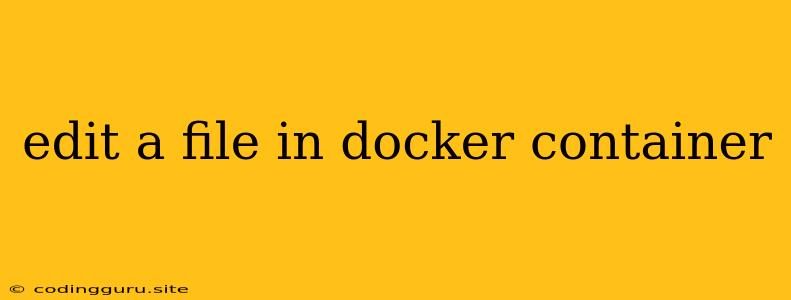How to Edit a File Inside a Docker Container
Working with Docker containers often involves making modifications to files within them. This could be for configuration changes, bug fixes, or simply updating content. However, directly editing files inside a running container can be tricky. This article will guide you through the best practices and methods for editing files within a Docker container.
Understanding the Challenges
Docker containers are designed to be immutable, meaning changes made within the container are not persistent. When the container stops, all modifications are lost. This is due to the nature of containers – they are isolated environments with their own file systems. So, how do you edit files in a container and make those changes stick?
Methods for Editing Files in Docker Containers
Here are the most common and effective techniques for editing files within a Docker container:
1. Mounting a Volume:
This is the most recommended and straightforward method. It allows you to create a connection between your host machine's file system and the container's file system. This way, any changes you make on the host will be reflected inside the container and vice-versa.
Steps:
- Define the volume in your Dockerfile:
FROM ubuntu:latest WORKDIR /app VOLUME /app/data - Start the container with the mounted volume:
docker run -v $(pwd)/data:/app/data -it ubuntu:latest bash
Explanation:
- -v: The
-vflag in thedocker runcommand allows you to mount a volume. - $(pwd)/data:/app/data: This specifies the mapping between the host directory (
$(pwd)/data) and the container directory (/app/data). Any file changes you make in thedatadirectory on your host will be reflected in the/app/datadirectory inside the container.
2. Using docker cp:
The docker cp command facilitates file transfer between your host machine and a running container. You can use it to copy files into a container or retrieve files from a container.
Steps:
- Copy a file from your host to the container:
docker cp your_file.txt container_id:/path/in/container - Copy a file from the container to your host:
docker cp container_id:/path/in/container your_file.txt
3. Running an Interactive Shell:
You can use docker exec to run a command inside a running container. This lets you access the container's shell and directly edit files using the container's text editor.
Steps:
- Enter the container's shell:
docker exec -it container_id bash - Use the container's text editor to make changes:
nano /path/to/file.txt
Remember: Changes made through docker exec will only persist while the container is running. Once the container stops, the changes will be lost.
Best Practices
- Use a dedicated volume for persistent data: Mounting a volume is the preferred method for editing files in Docker containers because it ensures that changes are persistent.
- Use a Dockerfile for creating images: This provides a structured and reproducible way to build your Docker image.
- Automate file changes: Whenever possible, automate changes to your files through scripts or container entry points. This reduces the need to manually edit files within the container.
- Choose the right method: Consider the specific needs of your project and the desired level of persistence for your file changes when selecting the most suitable method.
Conclusion
Editing files within a Docker container is a common task. Understanding the differences between the approaches outlined above will allow you to choose the most effective method for your specific needs. By using Docker volumes and docker cp, you can ensure that your changes are persistent and easily managed, while interactive shells provide flexibility for quick edits within the container environment.
